
The Interim Control Module (ICM) is a NASA-constructed module designed to serve as a temporary "tug" for the International Space Station in case the Zvezda service module was destroyed or not launched for an extended period of time. [1]

The Interim Control Module (ICM) is a NASA-constructed module designed to serve as a temporary "tug" for the International Space Station in case the Zvezda service module was destroyed or not launched for an extended period of time. [1]
It was derived from a formerly-classified Titan Launch Dispenser used to distribute reconnaissance satellites to different orbits. [2] It would have been able to prolong the lifespan of the Zarya module by providing equivalent propulsion capabilities to the Service Module, although not any of the other life support capabilities.
In 1997 NASA requested that the Naval Research Laboratory study the feasibility of adapting an existing, heritage spaceflight system to provide low-cost, contingency propulsion operations for the International Space Station (ISS).
After determining that the system could be adapted in time to meet NASA's schedule requirements, NRL was granted authority to proceed with the Interim Control Module (ICM). From its inception ICM was a contingency option for attitude control and reboost of the ISS that would allow NASA to preserve the on-orbit construction schedule in case of delays in the launch of the Russian Service Module.
ICM was to launch on board the Space Shuttle, deploy from the Shuttle's cargo bay, and mate with the ISS at the Russian Control Module (called Zarya). Once on orbit ICM would provide sufficient fuel for one to three years of operation.
— NRL Spacecraft Engineering Department, [3]
After the successful launch of Zvezda, ICM was placed in a caretaker status at NRL's Payload Processing Facility in Washington, D.C. Should it become necessary to complete and launch ICM, it was estimated that it would take between two and two-and-a-half years to do so. [4]
Since the ICM was mothballed, a variety of new uses for it have been proposed. Most seriously, it was proposed for use as part of a robotic servicing mission for the Hubble Space Telescope, [5] before the final Shuttle servicing mission was approved. The ICM has also been suggested as an integral part of a new telescope based on unused spy satellite hardware, [6] and even for use in its original role in the event of removal of the Russian Orbital Segment of the ISS. [7]

The International Space Station (ISS) is the largest space station to have ever been built. The station resides in low Earth orbit and has a primary purpose of performing microgravity and space environment experiments. As implied by its name, the International Space Station is a collaboration of five space agencies and other contractors. These agencies are: NASA, Roscosmos (Russia), JAXA (Japan), ESA (Europe), and CSA (Canada).

The Space Shuttle program was the fourth human spaceflight program carried out by the U.S. National Aeronautics and Space Administration (NASA), which accomplished routine transportation for Earth-to-orbit crew and cargo from 1981 to 2011. Its official name, Space Transportation System (STS), was taken from a 1969 plan for a system of reusable spacecraft of which it was the only item funded for development. It flew 135 missions and carried 355 astronauts from 16 countries, many on multiple trips.

The Salyut programme was the first space station programme, undertaken by the Soviet Union. It involved a series of four crewed scientific research space stations and two crewed military reconnaissance space stations over a period of 15 years, from 1971 to 1986. Two other Salyut launches failed. In one respect, Salyut had the task of carrying out long-term research into the problems of living in space and a variety of astronomical, biological and Earth-resources experiments, and on the other hand the USSR used this civilian programme as a cover for the highly secretive military Almaz stations, which flew under the Salyut designation. Salyut 1, the first station in the programme, became the world's first crewed space station.
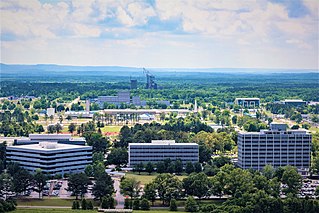
The George C. Marshall Space Flight Center (MSFC), located in Redstone Arsenal, Alabama, is the U.S. government's civilian rocketry and spacecraft propulsion research center. As the largest NASA center, MSFC's first mission was developing the Saturn launch vehicles for the Apollo program. Marshall has been the lead center for the Space Shuttle main propulsion and external tank; payloads and related crew training; International Space Station (ISS) design and assembly; computers, networks, and information management; and the Space Launch System. Located on the Redstone Arsenal near Huntsville, MSFC is named in honor of General of the Army George C. Marshall.
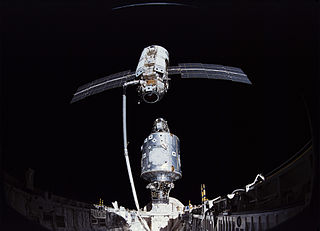
STS-88 was the first Space Shuttle mission to the International Space Station (ISS). It was flown by Space Shuttle Endeavour, and took the first American module, the Unity node, to the station.

STS-106 was a 2000 Space Shuttle mission to the International Space Station (ISS) flown by Space Shuttle Atlantis.

Nancy Jane Currie-Gregg is an American engineer, United States Army officer and a NASA astronaut. Currie-Gregg has served in the United States Army for over 22 years and holds the rank of colonel. With NASA, she has participated in four space shuttle missions: STS-57, STS-70, STS-88, and STS-109, accruing 1,000 hours in space. She currently holds an appointment as a professor of practice in the Department of Industrial & Systems Engineering at Texas A&M University.
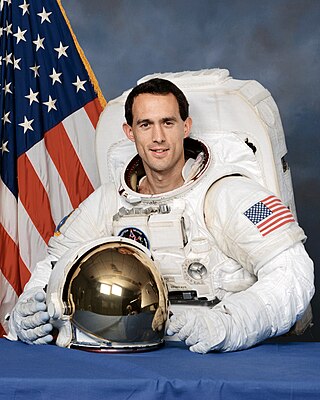
James Hansen Newman is an American physicist and a former NASA astronaut who flew on four Space Shuttle missions.

Zvezda, Salyut DOS-8, also known as the Zvezda Service Module, is a module of the International Space Station (ISS). It was the third module launched to the station, and provided all of the station's life support systems, some of which are supplemented in the US Orbital Segment (USOS), as well as living quarters for two crew members. It is the structural and functional center of the Russian Orbital Segment (ROS), which is the Russian part of the ISS. Crew assemble here to deal with emergencies on the station.

Zarya, also known as the Functional Cargo Block or FGB, is the first module of the International Space Station to have been launched. The FGB provided electrical power, storage, propulsion, and guidance to the ISS during the initial stage of assembly. With the launch and assembly in orbit of other modules with more specialized functionality, as of August 2021 it is primarily used for storage, both inside the pressurized section and in the externally mounted fuel tanks. The Zarya is a descendant of the TKS spacecraft designed for the Soviet Salyut program. The name Zarya ("Dawn") was given to the FGB because it signified the dawn of a new era of international cooperation in space. Although it was built by a Russian company, it is owned by the United States.
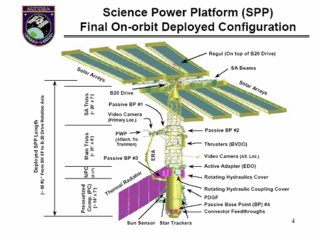
The Science Power Platform was a planned Russian element of the International Space Station (ISS) that was intended to be delivered to the ISS by a Russian Proton rocket or Zenit rocket but was shifted to launch by Space Shuttle as part as a tradeoff agreement on other parts of the ISS.

The ISS Propulsion module was proposed as a backup to functions performed by the Zvezda Service Module and Progress spacecraft. Critical ISS functionality such as guidance, navigation, control and propulsion are provided only by Russian and the European (ATV) spacecraft. A Propulsion Module would have been needed for ISS altitude maintenance and reboost, debris avoidance maneuvers, attitude control and propellant supply in the event the Zvezda Service Module was not available to the International Space Station. If the Zvezda had not been available, the Interim Control Module would have been used at first. It only had a lifetime of three years; then the Propulsion Module would have been necessary.
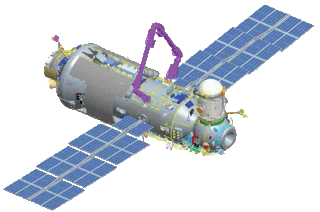
The European Robotic Arm (ERA) is a robotic arm that is attached to the Russian Orbital Segment (ROS) of the International Space Station. Launched to the ISS in July 2021; it is the first robotic arm that is able to work on the Russian Segment of the station. The arm supplements the two Russian Strela cargo cranes that were originally installed on the Pirs module, but were later moved to the docking compartment Poisk and Zarya module.

Mir-2 was a Soviet space station project which began in February 1976. Some of the modules built for Mir-2 have been incorporated into the International Space Station (ISS). The project underwent many changes, but was always based on the DOS-8 base block space station core module, built as a back-up to the DOS-7 base block used in the Mir station. The DOS-8 base block was eventually used as the Zvezda module of the ISS. Its design lineage extends back to the original Salyut stations.

Rassvet, also known as the Mini-Research Module 1 and formerly known as the Docking Cargo Module (DCM), is a component of the International Space Station (ISS). The module's design is similar to the Mir Docking Module launched on STS-74 in 1995. Rassvet is primarily used for cargo storage and as a docking port for visiting spacecraft. It was flown to the ISS aboard Space ShuttleAtlantis on the STS-132 mission on 14 May 2010, and was connected to the ISS on 18 May 2010. The hatch connecting Rassvet with the ISS was first opened on 20 May 2010. On 28 June 2010, the Soyuz TMA-19 spacecraft performed the first docking with the module.

The process of assembling the International Space Station (ISS) has been under way since the 1990s. Zarya, the first ISS module, was launched by a Proton rocket on 20 November 1998. The STS-88 Space Shuttle mission followed two weeks after Zarya was launched, bringing Unity, the first of three node modules, and connecting it to Zarya. This bare 2-module core of the ISS remained uncrewed for the next one and a half years, until in July 2000 the Russian module Zvezda was launched by a Proton rocket, allowing a maximum crew of three astronauts or cosmonauts to be on the ISS permanently.

Grapple fixtures are used on spacecraft or other objects to provide a secure connection for a robotic arm.

The Russian Orbital Segment (ROS) is the name given to the components of the International Space Station (ISS) constructed in Russia and operated by the Russian Roscosmos. The ROS handles Guidance, Navigation, and Control for the entire Station.

Strela is a class of four Russian-built cargo cranes used during EVAs to move cosmonauts and components around the exterior of the Soviet/Russian space station Mir and the Russian Orbital Segment of the International Space Station.

Docking and berthing of spacecraft is the joining of two space vehicles. This connection can be temporary, or partially permanent such as for space station modules.